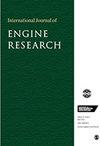后处理系统的高效产品设计工具
IF 2.1
4区 工程技术
Q2 ENGINEERING, MECHANICAL
引用次数: 0
摘要
为了以最低成本优化后处理系统,我们开发了一种基于气相质量和能量守恒的数值模拟技术。储氧能力模型和催化剂劣化模型均已集成到三元催化剂性能模型中。讨论的应用包括 XY-L 1.5L I3 汽油涡轮增压直喷(GTDI)量产混合动力汽车、BY-L 1.5L I4 GTDI 混合动力汽车、XY-L(海外版)1.5L I4 GTDI 混合动力汽车和 G-L7 1.5L I4 GTDI 混合动力汽车。对支持拟议模型的车辆测试进行了描述。开发的模型涵盖了冷启动、高温和体积流量条件的全部范围。为了优化三元催化器的性能,这项工作模拟了空气燃料比、空间速度、温度、偏置调整对催化剂效率的影响。模拟结果表明,该技术能够很好地预测新旧后处理系统的排放情况,并在瞬态条件下进行。调查表明,在发动机启动时,过量的燃料被用来加热催化剂,使其达到 350°C 以上的全工作温度。模型结果促使对 I3 和 I4 1.5L GTDI 中国 6b、欧 VId 和 Tier 3/SULEV30 排气系统分别在世界轻型车辆测试程序 (WLTP) 和联邦测试程序 (FTP) 循环中进行了重新设计,例如,模型建议对 XY-L(海外版)1.5L I4 GTDI 混合动力车的 SULEV30 后处理系统进行最新设计。5L I4 GTDI 混合动力汽车的后处理系统的最新设计,在冷启动和闭环燃料领域对 NMOG、NOx 和 CO 的排放进行了修订校准,使其达到 SULEV30 标准的 70%,与基准相比,成本降低了 64 美元。本文章由计算机程序翻译,如有差异,请以英文原文为准。
An efficient product design tool for aftertreatment system
A numerical simulation technique based on the conservation of mass and energy in the gas phase has been developed to optimize the aftertreatment system with the lowest costs. Both oxygen storage capacity model and catalyst deterioration model have been integrated into the three-way catalyst performance model. Applications have been discussed, including XY-L 1.5L I3 gasoline turbocharged direct injection (GTDI) production hybrid vehicle, BY-L 1.5L I4 GTDI hybrid vehicle, XY-L (overseas version) 1.5L I4 GTDI hybrid vehicle, and G-L7 1.5L I4 GTDI hybrid vehicle. Vehicle tests in support of the proposed model have been described. The developed model covers the complete range of the cold start, high temperature and volume flow conditions. To optimize a three-way catalyst performance, this work simulated the effect of air fuel ratio, space velocity, temperature, biasing adjustment on the catalyst efficiency. The simulations presented the technique’s capability of well predicting emissions on fresh and full useful life aged aftertreatment systems, respectively, and carried out under transient conditions. The investigation indicated that excess fueling was used upon engine start to heat the catalyst up to its full operating temperature of greater than 350°C. The model results prompted a redesign of the I3 and I4 1.5L GTDI China 6b, Euro VId and Tier 3/SULEV30 exhaust systems over the world light vehicle test procedure (WLTP) and federal test procedure (FTP) cycles, respectively, for example, the model suggested that the latest design for the SULEV30 aftertreatment system on XY-L (overseas version) 1.5L I4 GTDI hybrid vehicle with the revised calibrations in the areas of cold-start and closed-loop fuel treated emissions of NMOG, NOx, and CO to the 70% of the SULEV30 standards with a $64 cost reduction relative to the baseline.
求助全文
通过发布文献求助,成功后即可免费获取论文全文。
去求助
来源期刊

International Journal of Engine Research
工程技术-工程:机械
CiteScore
6.50
自引率
16.00%
发文量
130
审稿时长
>12 weeks
期刊介绍:
The International Journal of Engine Research publishes high quality papers on experimental and analytical studies of engine technology.
 求助内容:
求助内容: 应助结果提醒方式:
应助结果提醒方式:


